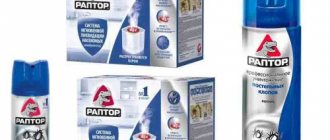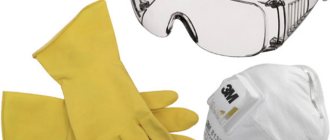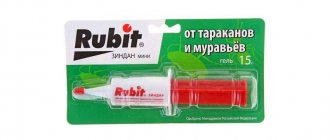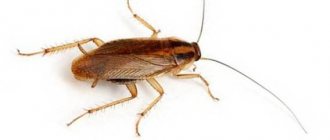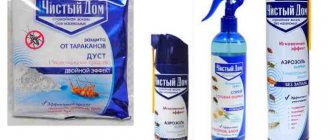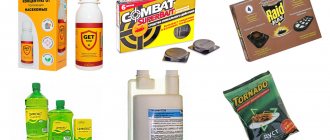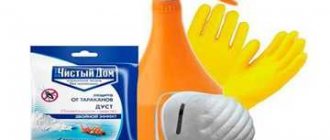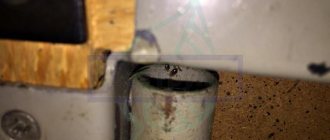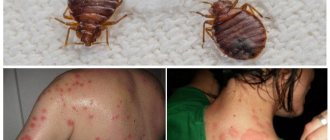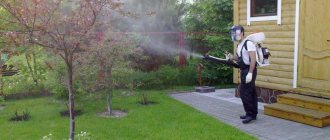If you accidentally notice cockroaches or other synanthropic insects in your home, then you should not immediately start panicking. Now you can find a large number of effective insecticides that will help control pests forever. We offer to buy FAS Cypermethrin for domestic use.
The product has always been available only to workers of professional pest control services, but now you can also order a compact bottle. The manufacturer has tested the formula many times and has proven the composition to be 100% effective.
Composition and principle of action of cypermethrin
The work of the insecticide is based on a paralytic mechanism of action on the nervous system of insects; it is effective against both adults and their larvae. Cypermethrin, the active substance of which consists of a mixture of various modifications of cyclopropanecarboxylic acid ester, due to the peculiarities of its composition, cypermethrin is resistant to light and atmospheric oxygen.
Strict adherence to instructions and dosages guarantees achievement of the desired result and long-lasting effect on the treated area.
Origin
The drug cypermethrin belongs to the group of pyrethroid insecticides. They originate from plants of the genus pyrethrum (Pyrethrum spp.), well known to flower growers as Dalmatian chamomile, pink pyrethrum, maiden pyrethrum, etc., see figure. Even in ancient times, it was noticed that bedbugs, fleas and cockroaches are reluctant to settle indoors , hung with bunches of dry pyrethrum, and ixodid ticks are never found on Dalmatian chamomile.
Pyrethrum plants
In the 19th century The substances pyrethrins, “responsible” for scaring away unwanted cohabitants, were isolated from pyrethrums. However, they turned out, firstly, to be more of a repellent - they repelled pests rather than destroyed them. Secondly, pyrethrins quickly decomposed in light and air. In the 70s of the last century, based on pyrethroids, synthetic extremely powerful insecticides and pyrethroid acaricides, resistant to oxidation by atmospheric oxygen and the action of light, were obtained.
Types of the drug and release forms
Cypermethrin in its pure form is a transparent, colorless liquid with a specific odor.
Insecticidal products based on it, available to the end consumer, can be:
- water soluble powder;
- wettable powder;
- mother liquor;
- concentrated emulsion;
- pills.
More than 200 different drugs containing cypermethrin are produced worldwide. About 50 of them are for domestic use.
Alpha
Alpha-cypermethrin is a racemic mixture based only on cis-isomers of the base substance. This is a viscous, colorless mixture that has a long-lasting effect and is effective at all stages of insect development. The drug is resistant to climate change and does not enter groundwater. Safe for bees, birds and mammals.
Beta
Beta-cypermethrin is a racemic mixture of cis and trans isomers in a ratio of approximately 40:60. Physically it is a white crystalline powder, which is practically insoluble in water, but is easily diluted in organic solvents. Most often used against larvae and adult insects. Dangerous for bees and fish, moderately dangerous for humans.
Zeta
Zeta-cypermethrin is a racemic mixture consisting of both cis and trans isomers, containing the 4 most active isomers with the S configuration of the cyano group. Unlike all other modifications, it is an optically active substance. It is a dark brown mixture that has good solubility in most organic solvents.
When used correctly, the drug is practically safe for humans and non-toxic for bees.
Customer Reviews
Nikita, 41
I used Cypermethrin at the dacha and was very pleased with the results. I used it against ants, but I never saw a single insect in the house. A neighbor used it for the Colorado potato beetle and was also pleased, it was fast and very effective.
Olga, 32
I have used a lot of products to get rid of cockroaches. I have small children, so I avoided dangerous insecticides, but I still had to because nothing helped. We moved with the children for a week, during which time we treated them with cypermethrin, got rid of all the Prussians and cleaned all surfaces of insecticide for safety reasons.
Victor, 52
I am pleased with the results of Cypermethrin. He is carrying out pest control at his home, did everything according to the instructions, then just removed the dead Prussians. Two weeks later I repeated the procedure. Got rid of all the cockroaches. Now I really use traps for prevention purposes.
Pest control effectiveness
Various insecticidal preparations based on cypermethrin have been used for many years in various industries and have proven themselves to be a reliable product. For more effective use of the drug and causing the least possible harm to others, first determine the places of maximum accumulation of insects. Based on the experience of using cypermethrin, standard methods for working with the most common insects have been developed.
Bedbugs
The destruction of bedbugs is carried out using an aqueous emulsion of an insecticide with a concentration of 0.01%. The drug is used to treat all surfaces where insects can enter.
The most thorough treatment is carried out in the area:
- skirting boards;
- door blocks;
- carpets and runners on both front and back sides;
- places where laminate and wallpaper are peeling off;
- all possible cracks and unevenness of the floor and walls.
A bedbug repellent based on cypermethrin emulsion is most effective if preliminary work is carried out correctly to identify places where parasites accumulate and live. It is prohibited to use cypermethrin for treating bedding.
Cockroaches
When treating a room against cockroaches, an aqueous emulsion with a concentration of 0.1% is used. The composition is applied to all surfaces accessible to insects, including possible paths of insects to food and water.
Mosquitoes
To combat mosquitoes, an emulsion of the drug with a concentration of 0.01% is used. To achieve the desired effect, the insecticide is sprayed on areas where insects frequently accumulate, the walls of houses and places where garbage accumulates.
Fleas and ticks
For ticks and fleas, cypermethrin is used in the form of an aqueous emulsion with a concentration of 0.1%. The product is sprayed on walls, baseboards and floors to a height of up to 1 m. Particular attention is paid to the treatment of cracks and various irregularities.
Ants
When fighting ants, an insecticide emulsion containing 0.01% of the drug is used. Special attention should be paid to areas of compact habitat and accumulation of insects, as well as ant “paths” along which insects move.
Properties
The product has an acute insecticidal effect against cockroaches, ants, bedbugs, fleas, flies, mosquitoes, rat ticks and residual activity for 1-1.5 months.
According to the degree of impact on the body of warm-blooded animals, when introduced into the stomach, the product belongs to the 3rd class of moderately dangerous products, and with a single exposure to the skin - to the 4th class of low-hazard products according to GOST 12.1.007-76. Does not have a local irritant effect upon single exposure to the skin. A weakly expressed sensitizing effect was revealed. When exposed to the mucous membranes of the eyes, the product causes a pronounced effect (conjunctivitis); in the vapors of the working aqueous emulsion (0.1% by DV), the sensitizing effect has not been established, but a moderately pronounced irritant effect on the mucous membranes of the eyes has been detected. With a single inhalation exposure to an aerosol of 0.1% aqueous emulsion, the product in the zone of acute biocidal effect belongs to class 2, highly hazardous according to the Classification of the degree of hazard of disinfestation agents. Vapors of 0.1% aqueous emulsion in the zone of biocidal effect are classified as 4 low-hazardous in accordance with the Classification of the degree of hazard of disinfestation agents.
With repeated contact with intact skin of the working aqueous emulsion (0.1% DV), no skin-resorptive effect was detected, but a weakly expressed local irritant effect was established. The maximum permissible concentration in the air of the working area of the active substance - cypermethrin is 0.5 mg/m2 (vapor + aerosol) - hazard class 2.
Comparative characteristics of the repellent with other drugs
Compared to other insecticides, cypermethrin has relatively low toxicity to humans, and therefore is available for use by non-professionals. In addition, it is not addictive to insects, which is important for regular use. In low concentrations, preparations based on it not only destroy, but also repel insects.
There is only one significant drawback of cypermethrin - the insecticide does not act on insect eggs.
A drug similar in scope, chlorpyrifos, is a more effective, but very toxic insecticide, available only to professionals and is usually used in agriculture or for sanitary treatment. Unlike cypermethrin, it destroys insect eggs. What is better to use - chlorpyrifos or cypermethrin - is determined individually, based on the circumstances of each situation.
First aid for poisoning when working indoors
- If safety rules are violated or in accidents, acute poisoning may develop. Signs of poisoning: unpleasant taste in the mouth, weakness, vomiting, headache, nausea (increased by smoking, eating), abdominal pain, irritation of the respiratory system, excessive salivation.
- In case of poisoning through the respiratory tract, remove the victim to fresh air, remove contaminated clothing, and rinse the mouth with water or a 2% solution of baking soda. Then give 1-2 glasses of water with activated carbon (10-15 tablets) to drink.
- If you accidentally get the product into your eyes, rinse them thoroughly under running water or a 2% solution of baking soda for several minutes. If irritation of the mucous membrane occurs, drip a 30% solution of sodium sulfacyl into the eyes; if pain occurs, drop a 2% solution of novocaine into the eyes.
- If the skin is contaminated, remove drops of emulsion with a cotton swab or rag without rubbing; why wash the contaminated area with soap and water.
- If the product accidentally gets into the stomach, drink several glasses of water and induce vomiting, then rinse the stomach with a 2% solution of baking soda or drink 1-2 glasses of water with activated carbon (10-15 tablets). Never induce vomiting or put anything into the mouth of an unconscious person.
- After providing first aid, the victim should consult a doctor. Treatment is symptomatic.
Method of application and consumption rates
The most common method of using the drug is spraying an aqueous emulsion with a concentration of up to 0.1% inclusive. The use of more concentrated solutions requires the participation of professionals. Various emulsions are commercially available. The most concentrated option available to non-professionals is cypermethrin 25 (the instructions for use state that the number corresponds to the content of the active insecticide). Cypermethrin instructions for use provide for preliminary preparation of the solution.
The consumption rates of the finished emulsion depend on the type of insects being destroyed:
- against cockroaches, bedbugs and fleas: 0.1% solution, 50 ml./sq.m. non-absorbent surface and 100 ml./sq.m. for absorbent;
- against flies: 0.01% solution 100 ml/sq.m.;
- from ants: 0.05% solution 50 ml./sq.m.;
- from hornets and wasps: 0.1% solution 100-200 ml./sq.m.
Cifox
You can easily buy Tsifoks in hardware stores - a yellowish liquid with a pungent aroma. Contains 25% cypermethrin. The product is available in plastic bottles with a capacity of 50 to 1000 ml.
The drug effectively destroys pests and protects the apartment from re-infestation.
- The instructions say that the solution is diluted with water before use.
- To eliminate a small colony of cockroaches, dissolve 1 ml of the substance in 1000 ml of water.
- If numerous nests are found, double the concentration.
- Mix the liquid thoroughly, place in a spray bottle and spray the room.
In reviews of Tsifoks against cockroaches, people emphasize its speed. Insects die en masse 30 minutes after exposure to the insecticide. Among the disadvantages, buyers consider the need to dilute the product and adhere to the proportions.
Duration of protection and re-treatment
The duration of action is 10-15 days. The greatest effectiveness is achieved during the first 2-3 hours. Upholstered furniture and vegetation retain cypermethrin for up to 3 weeks, heavy soils - up to 10 weeks, finishing materials and light soils - up to 4 weeks. With proper processing, the period of protection of cypermethrin from bedbugs is 1.5 months, reviews confirm this, and from cockroaches - about 60 days.
The need for re-treatment is determined individually in each individual case and depends on the effectiveness of the initial measures taken. If parasites appear after the end of the period of action of the insecticide, additional treatment with the insecticide is carried out.
Purpose
The product is intended for the destruction of cockroaches, ants, bedbugs, fleas, flies, mosquitoes and rat mites in objects of various categories: in residential and non-residential premises, hotels, hostels, in public catering establishments (on weekends or sanitary days) by personnel of organizations engaged in disinfection activities , as well as to combat ixodid ticks (carriers of tick-borne encephalitis, Lyme disease and other diseases) when processing natural sites by professional contingent (employees of institutions authorized to engage in disinfection activities, supervisory authorities in the field of consumer rights protection and human well-being).
Toxicity of the drug and safety precautions
Cypermethrin-based drugs belong to toxicity classes 2 and 3 due to their high danger to humans.
If used incorrectly, poisoning, severe neurotoxic and allergic reactions are possible, characterized by the following symptoms:
- gait disturbance;
- slow reaction;
- salivation;
- convulsions.
Cypermethrin vapors are explosive, and the substance itself ignites at temperatures above 300 degrees Celsius, and therefore the use of the drug is prohibited near open fire sources and hot objects.
The permissible concentrations of the drug are:
- residential air: 0.01 mg/cub.m;
- human body: 0.01 mg/kg;
- natural reservoirs: 0.4 mg/cub.m;
- open air: 0.006 mg/cub.m;
- soil: 0.02 mg/kg.
When treating with insecticide, the following precautions must be observed:
- The occupants of the premises are removed to a safe place for at least a day.
- Children, nursing and pregnant women, people with allergies can move into the treated premises after at least 3-4 days.
- In the room being treated, as well as in the immediate vicinity, all work involving the use of welding and open fire is stopped, heating and electrical appliances are turned off.
- The presence of a source of clean air, exhaust and ventilation in the room is checked.
When treating premises with air aerosol mixtures, the following personal protective equipment is mandatory:
- Jumpsuit made of thick water-repellent fabric with a tightly sewn hood.
- Full-face respirator. To purify the air, a gas cartridge of grade “A” must be used.
- Technical rubber gloves. The use of medical and household gloves is strictly prohibited.
- Protective sealed glasses of monoblock type.
- Rubber boots.
Only clean protective clothing may be used. After completing the work, all used products and tools are transferred to a separate non-residential area and washed in the shower. The surfaces of gloves, boots, glasses and a respirator must be cleaned with a soap solution and then rinsed with clean water. Clothing should be washed in a soda ash solution (5 mg/liter of hot water), rinsed in clean water, and then dried in a ventilated area.
Precautions when working in open areas
- Before starting work, the responsible work manager conducts special instructions on work rules, storage, precautions and first aid, familiarizes all workers with the characteristics of the product, its toxicity, as well as measures to prevent contamination of reservoirs, apiaries, etc. with the product.
- When processing natural sites, it is necessary to comply with the water protection zones of rivers, ponds, lakes, reservoirs, zones of the first and second zones of sanitary protection of water supply sources and air intake devices. It is prohibited to cultivate areas located near fishing and drinking water bodies at a distance of 500 m from the flood line at maximum flood waters, but not closer than 2 km from the existing banks. Grazing of livestock, picking berries and mushrooms in the treated area is permitted no earlier than 40 days after treatment.
- The population living near the treated area must be informed in advance about the places and timing of the treatments (radio, television or written notification). Uniform safety signs are placed at the border of the treated area; the signs are removed after the established deadlines. The information should include the following information: the danger of tick vectors, the need for treatment, the safety of the product in the recommended mode of use for human health and for the preservation of natural biotopes, the prohibition of grazing livestock, picking berries and mushrooms in the treated area.
- The use of the product requires compliance with the basic provisions of the “Instructions for the prevention of bee poisoning by pesticides” (M., GAPSSSR, 1989). It is necessary to promptly notify the owners of apiaries about the places and timing of treatments (at least 2 days before treatments) and the need to protect bees. Treatment times are morning and evening. Treatment is carried out using low-volume ground spraying at wind speeds of up to 1-2 m/sec. In order to protect apiaries from the effects of the product, it is necessary to take them to another source of honey collection at a distance of at least 5 km from the treated areas (border protection zone) and isolate them in any way for up to 10 days after treatment. The summer limit for bees is 96 -120 hours.
- The preparation of aqueous emulsion and filling of containers is carried out at specially equipped filling points. The refueling point should be located no closer than 200 m from livestock grazing areas and water bodies. If the soil is accidentally contaminated with the product, it is disinfected.
- Places where work is carried out with the product are supplied with water, soap, towels and a first aid kit.
Cross use with other chemicals
There are a number of preparations in which cypermethrin is used in mixture with other insecticides to achieve greater effect:
- "Sichlor" - created on the basis of cypermethrin and chlorpyrifos;
- “Gulliver” - contains alpha-cypermethrin, lambda-cyhalothrin, thiamethoxam;
- "Killer" - contains cypermethrin and chlorpyrifos.
In the case of independently preparing mixtures, select insecticides that have mutually complementary properties. For joint use with cypermethrin, a substance is selected that affects insect eggs. It is unacceptable to use cypermethrin together with alkaline preparations.
Delcid
To eliminate cockroaches in an apartment, the oily liquid Delcid, sold in ampoules, is suitable. One dose will mix 2 ml of emulsion.
The composition contains the insecticide deltamethrin, which, like cypermethrin, belongs to the second generation pyrethroids. The substance blocks the neuromuscular impulses of insects, making it difficult to breathe and swallow food. Under the influence of poison, pests cannot move and die.
Auxiliary components of the emulsion are:
- neonol;
- twin;
- nefras.
To prepare the solution, open the ampoule and pour the contents into 800 ml of water. Stir the liquid for 15-20 minutes.
In reviews, people write that they get scared when the composition turns white and becomes milky. This doesn't mean it's damaged. This is how the chemical reaction occurs when deltamethrin comes into contact with water.
For 1 square meter of area, 25-50 ml of solution is required. Place it in a spray bottle and use it for pest control.
